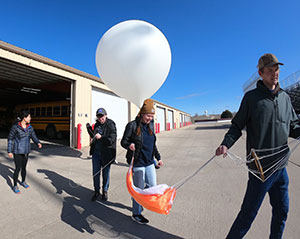
Contact Us
Institutional Communications
Bureau of Mines Building, Room 137
Laramie, WY 82071
Phone: (307) 766-2929
Email: cbaldwin@uwyo.edu
UW Students to Participate in Nationwide Eclipse Ballooning Project This Fall and Next Spring
Published May 08, 2023

The University of Wyoming is one of 55 colleges and universities nationwide that
have been selected for the Nationwide Eclipse Ballooning Project. Teams will conduct
research with weather balloons during future eclipses scheduled this October and in
April 2024. Here, UW students transport the high-altitude balloon and payload items
from a sheltered area inside a garage, where the balloon was inflated, to the nearby
football field during a recent Wyoming NASA Space Grant Consortium K-12 outreach balloon
launch event at Torrington Middle School April 21. Pictured, from left, are UW Ph.D.
student Lauren Kim and undergraduate student participants Samantha Smith, Riley Geldean
and Carson Rardin. Phil Bergmaier, a postdoctoral research associate in the UW Department
of Physics and Astronomy, is obscured behind Geldean and holding the balloon. (Wyoming
NASA Space Grant Consortium Photo)
Up, up and away.
A team of eight University of Wyoming students will have the opportunity this fall and in spring 2024 to conduct research with weather balloons during future eclipses as part of the Nationwide Eclipse Ballooning Project (NEBP).
UW was chosen in the atmospheric science category. Teams with atmospheric science projects will fly small weather sensors as high as 115,000 feet each for 30 hours along the eclipse path.
NEBP includes 55 teams from colleges and universities around the country. Started in 2014 by Montana State University, the original NEBP involved more than 50 teams that livestreamed and studied the 2017 total solar eclipse. In 2022, Montana State University was awarded a $6.5 million grant from NASA to extend and improve upon the project for the 2023 and 2024 solar eclipses. Since its inception, NEBP has supported studies during eclipses in 2017, 2019 and 2020.
“Our team will actually be flying many high-altitude balloons during both the October 14, 2023 annular solar eclipse and the April 8, 2024 total solar eclipse as part of the Nationwide Eclipse Ballooning Project,” says Phil Bergmaier, a postdoctoral research associate in the UW Department of Physics and Astronomy and high-altitude balloon specialist with the Wyoming NASA Space Grant Consortium, who will serve as the main team lead for the project.
Bergmaier co-leads the project with Lauren Kim, a UW Ph.D. student from Fairport, N.Y., majoring in physics, and Shawna McBride, a senior research scientist in physics and astronomy and director of the Wyoming NASA Space Grant Consortium at UW.
Participating UW students, listed by hometown, year in school and major, are:
Athens, W.Va. -- Sydney BenChaabane, a sophomore majoring in astronomy and astrophysics.
Cincinnati, Ohio -- Samantha Smith, a sophomore majoring in computer engineering.
Cody -- Hunter Kindt, a junior majoring in mechanical engineering.
Coeur d’Alene, Idaho -- Amelia Myers, a freshman majoring in astronomy and astrophysics.
Erie, Colo. -- Riley Geldean, a junior majoring in chemical engineering.
Gillette -- David Gordon, a sophomore majoring in astronomy and astrophysics.
Lone Tree, Colo. -- Carson Rardin, a junior majoring in statistics.
Rock Springs -- Erin Poyer, a junior majoring in mechanical engineering.
“For both of these upcoming eclipses, our UW team will fly half-pound weather sensor packages, called radiosondes, on small balloons once every hour for 30 hours around the eclipse time,” Bergmaier explains. “The balloons will carry the radiosondes as high as 115,000 feet above sea level, well into the stratosphere. The radiosondes will measure temperature, humidity, air pressure, wind speed and direction, altitude, latitude and longitude.”
Bergmaier says the team will attempt to determine how the total solar eclipse impacts the atmosphere. During the eclipse, the moon is situated between the sun and Earth, casting a shadow on Earth and causing sudden darkness along the eclipse path. Within the shadow, there is abrupt cooling of the atmosphere, which can trigger “gravity waves,” he says.
“Gravity waves, which are different from gravitational waves, are similar to the ripples you would see when you toss a rock into a pond,” Bergmaier says. “They are quite common in our atmosphere but can be challenging to detect with radiosondes. Nevertheless, we hope to be able to detect eclipse-driven gravity waves in the upper atmosphere using our radiosonde measurements.”
To do so, Bergmaier says the team will need data that is detailed in both time and space. With 19 of the NEBP teams flying radiosondes along the eclipse paths every hour, the groups will collectively have an unprecedented data set that will be analyzed for years.
“The eclipse is, thus, a unique and rare time to study these phenomena, which can help scientists better understand the overall dynamics of the atmosphere and improve weather forecasting,” he says.
A team composed of both UW and Casper College students participated in the first NEBP for the 2017 eclipse. At that time, a balloon was launched from Casper, and video footage was livestreamed from the balloon to the internet during that eclipse, Bergmaier says.
Teams from Casper College and Central Wyoming College in Riverton were selected in the engineering category this year. For engineering projects, each team will launch one balloon during each eclipse. The balloons will float their 12-pound payloads, which include livestreaming cameras, at approximately 70,000 feet.
“Those college teams have limited prior experience flying high-altitude balloons. As someone who has flown more than 70 high-altitude balloons with the Wyoming Space Grant Consortium at UW, I will be providing some assistance and guidance to these other teams as they learn more about high-altitude ballooning,” Bergmaier says. “In addition, all three of our teams will be co-located to launch our balloons together at Snow College in Richfield, Utah, during the 2023 annular eclipse. We also may share a launch location during the 2024 total eclipse, but that location is still to be determined.”
Contact Us
Institutional Communications
Bureau of Mines Building, Room 137
Laramie, WY 82071
Phone: (307) 766-2929
Email: cbaldwin@uwyo.edu
